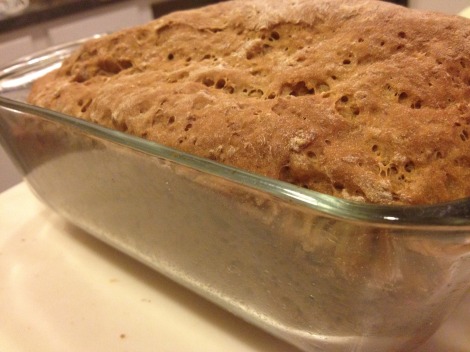
Making bread is exhausting. It takes forever and you feel like you’re stuck in the kitchen all day long. So when you get around to actually doing it, it’d better be worth the effort once it’s out of the oven. That said, it’s really not often that you taste a loaf of bread that makes you say, “Wow, I don’t think I’ve ever tasted bread that tastes like this before.” I mean, bread is bread, right? But when you add 1/2 cup of molasses to a bread that isn’t a sweet quickbread (like maybe pumpkin bread or something like that), it lends a really unique flavor!
Here’s a brief culinary history lesson on yeast, and the mysterious “yeast cake” required by this recipe (via wikipedia):
In 1879, Great Britain introduced specialized growing vats for the production of S. cerevisiae, and in the United States around the turn of the century centrifuges were used for concentrating the yeast, making modern commercial yeast possible, and turning yeast production into a major industrial endeavor. The slurry yeast made by small bakers and grocery shops became cream yeast, a suspension of live yeast cells in growth medium, and then compressed yeast, the fresh cake yeast that became the standard leaven for bread bakers in much of the Westernized world during the early 20th century.
During World War II, Fleischmann’s developed a granulated active dry yeast for the United States armed forces, which did not require refrigeration and had a longer shelf life and better temperature tolerance than fresh yeast; it is still the standard yeast for US military recipes. The company created yeast that would rise twice as fast, cutting down on baking time. Lesaffre would later create instant yeast in the 1970s, which has gained considerable use and market share at the expense of both fresh and dry yeast in their various applications.
2 other interesting things I didn’t realize before investigating this recipe: prior to Pasteur’s discovery that yeast is actually a living organism (around 1860), bread wasn’t made with “yeast”, it used “leaven” which you can create yourself over the course of a few days by leaving out a mixture of flour & water and waiting for yeast in the air to come feast on the paste. Talk about requiring patience! Also, apparently, yeast cake (or compressed yeast) is still available and a favorite for professional bakers because it’s quicker-acting. It’s not as widely used by home bakers anymore because its shelf life is extremely limited in comparison with its powdered counterpart (and most people just don’t bake bread all that often).
I’m a huge fan of how this old recipe worked out. Sliced thin (I had to use my electric bread knife because it came out really super soft), and with a good schmear of salted butter, it’s heavenly. Look at that beautiful top crust; golden and full of little holes. Gorgeous.
The recipe didn’t actually include cooking instructions (Gramma and I like to imagine that back when these recipes originated, you’d have to be a total idiot to not know how long to cook a loaf of bread). Instead, we just tried to recreate the most generic bread making possible: we kneaded the dough a bit even though the instructions didn’t say to (you’d have to be an idiot to not know that you need to knead bread dough, um, right? haha.) We cooked it in a 350 degree oven for 35 minutes. We undershot a little, and wished we’d left it in 45 (hence the softness).
So there it is. Amazingly odd tasting rolled oat molasses bread… But it really does feel like you’re eating history, something that’s truly been lost, and that is totally worth an afternoon in the kitchen.
Rolled Oat Bread
(makes 2 loaves)
1 c oats + 2c boiling water – combine and let sit for 1 hour
4t active dry yeast (in place of the yeast cake) + 1/2c lukewarm water – combine & let yeast soften
1/2c molasses
1 1/2t salt (use normal iodized. If using Kosher, double it.)
1T shortening
4.5c flour
Knead gently, adding a little flour if you need to to get the dough dry enough to work.
Let rise (in pans in a warm, draft free location)
Bake at 350 for 45 minutes


